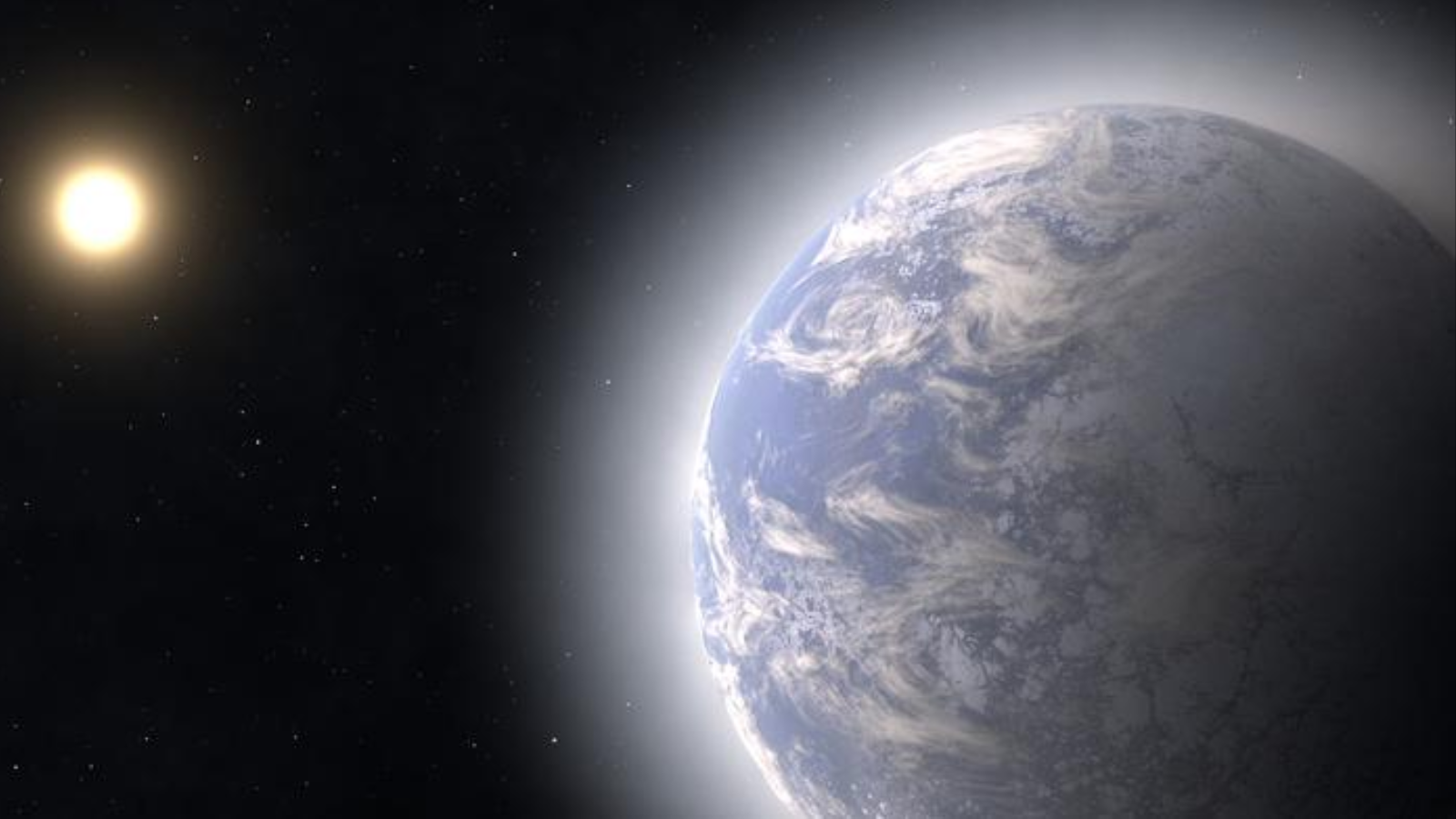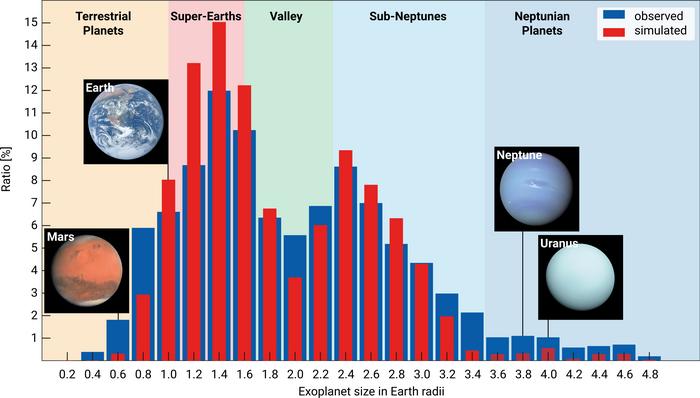The mystery of the missing super-Earths and mini-Neptunes may finally be solved
Astronomers may be ready to explain our universe's lack of exoplanets twice the radius of Earth.

Scientists have found some planets may migrate toward the hearts of their planetary systems early on in their lives, possibly explaining the lack of planets we see that are around twice the width of Earth.
Over the years, scientists have managed to observe many exoplanets that are either smaller or larger than Earth, but planets precisely between 1.6 and 2.2 times the size of our world are relatively scarce. In particular, exoplanets defined as super-Earths or mini-Neptunes appear to be missing in space. They're classified as such if they're slightly larger than twice the size of our planet, but still smaller than the ice giant Neptune.
The absence of these planets has thus become known as the "radius valley" or "radius gap," and has troubled scientists for a long time.
But now, new research suggests the "missing" super-Earths and mini-Neptunes may have just taken different routes out of the radius valley.
"Six years ago, a reanalysis of data from the Kepler space telescope revealed a shortage of exoplanets with sizes around two Earth radii," Remo Burn, an exoplanet expert at the Max Planck Institute for Astronomy, said in a statement.
Related: Surprise! Baby exoplanets might look like Smarties candies rather than spheres
Scientists have known for many years that planets could either move toward or away from their parent stars after formation, but what wasn't previously known was just how effective this migration would be in creating the radius valley.
Get the Space.com Newsletter
Breaking space news, the latest updates on rocket launches, skywatching events and more!
The most common explanation for the valley, Burn says, has to do with stars irradiating the planets that closely surround them, stripping the atmospheres of those worlds and causing them to shrink. This theory on its own, however, wasn't satisfactory for him. "This explanation neglects the influence of planetary migration," he explained.
Thus, Burn led a team of researchers that set out to investigate whether planetary migration could supplement the standard explanation and further explain the reason so few super-Earths and mini-Neptunes are seen orbiting close to their stars.
Super-Earths shrink while sub-Neptunes grow
Because the two planets that occupy the radius gap, super-Earths and mini-Neptunes, are both absent from the solar system, scientists can't quite study either up close. Howeer, researchers are fairly sure that super-Earths are rocky or terrestrial planets, while the characteristics of mini-Neptunes are much less certain.
What scientists also agree on is that mini-Neptunes, also known as sub-Neptunes, should have atmospheres that extend far beyond those of rocky planets.
Burn and the team wanted to know if this fact could play a role in creating the radius valley, and if the very existence of that valley could suggest very different formations and evolutions for super-Earths and mini-Neptunes.
Performing a re-analysis of a simulation the team ran in 2020, Burn and colleagues factored in processes in the gas and dust disks surrounding young stars that give rise to new planets, the emergence of atmospheres, and the migration of planets.
Crucial to the simulation and to developing a potential solution for the radius valley — that also factors in planetary migration — was understanding how water acts over a wide range of pressures and temperatures. That's because these parameters allow for a more realistic calculation of sub-Neptunes’ behavior.
"It's remarkable how, as in this case, physical properties on molecular levels influence large-scale astronomical processes such as the formation of planetary atmospheres," team member and MPIA Director, Thomas Henning, said in the statement.

The team found that moving toward a parent star had drastically different effects on both super-Earths and mini-Neptunes.
Mini-Neptunes are born away from their parent stars in the icy outer regions of their systems. While some of these planets remain in this place of birth, receiving low doses of radiation from their star, mini-Neptunes that do migrate inwards toward their star would have their icy material thawed, the team realized.
This would create a thick water atmosphere around these exoplanets, thus increasing their radii and shifting their widths beyond planets in the radius gap. This is possible because current observations of worlds outside the solar system can't differentiate between an exoplanet's atmosphere and solid parts when calculating width. This effect, the scientists therefore estimate, causes a peak in exoplanets 2.4 times the size of Earth.
On the other hand, super-Earths that either migrate toward their host star or are born very close would have their atmospheres stripped by the intense radiation of their stars. That'd force the worlds to lose their atmosphere and become smaller. This effect, the team says, would create a bare rocky core and cause a peak in exoplanet sizes at only 1.4 times the width of Earth.
Put simply, that means as mini-Neptunes are moving out of the radius valley one way, super-Earths are evacuating it via the opposite exit. And both mechanisms result in a dearth of planets around twice the width of Earth.
The team's simulations used to potentially unravel this mystery could also have an impact in other areas of exoplanet science.
"If we were to expand our results to cooler regions, where water is liquid, this might suggest the existence of water worlds with deep oceans," Christoph Mordasin, team member and head of the Division of Space Research and Planetary Sciences at the University of Bern, said in the statement. "Such planets could potentially host life and would be relatively straightforward targets for searching for biomarkers thanks to their size."
The team's research was published Feb. 9 in the journal Nature Astronomy.
Join our Space Forums to keep talking space on the latest missions, night sky and more! And if you have a news tip, correction or comment, let us know at: community@space.com.

Robert Lea is a science journalist in the U.K. whose articles have been published in Physics World, New Scientist, Astronomy Magazine, All About Space, Newsweek and ZME Science. He also writes about science communication for Elsevier and the European Journal of Physics. Rob holds a bachelor of science degree in physics and astronomy from the U.K.’s Open University. Follow him on Twitter @sciencef1rst.
-
rod The article stated, "Over the years, scientists have managed to observe many exoplanets that are either smaller or larger than Earth, but planets precisely between 1.6 and 2.2 times the size of our world are relatively scarce."Reply
This site shows 5624 confirmed exoplanets now, https://exoplanet.eu/home/
Using SQL query I found 719 fall into the 1.6 up to 2.2 earth radii size. 55 Cnc shows up along with many others and at the end, Wolf 503. The NASA archive site shows 5573 confirmed, https://exoplanetarchive.ipac.caltech.edu/index.html
782 show radii 1.6 to 2.2 earth size. 55 Cnc e and Wolf 503 b at start and end of the query list. Migration scenarios to explain various exoplanet observations is intriguing, especially with the population documented today for exoplanets. -
Helio UPDATE: Since publication of this article, Feb., it seems the valley is filling quickly as more and more exoplanets offer better analyses.Reply
If you compare the deep valley graph in the article to the following, you'll see what I mean...
-
Helio Using the article's graph's Y-axis of the ratio of exoplanets, it's only appropriate to compare the two with the use of the ratios. IIRC, they had about 2,000+ exoplanets for their data, so less than half of today.Reply
picture share
